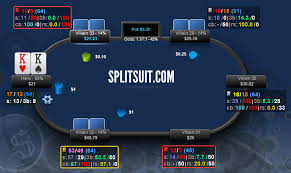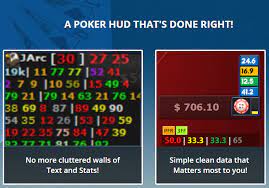Understanding the Role of HUDs in Poker
There are notable differences between live and online poker. Online poker allows players to handle a large volume of hands in a short period, while live poker provides the advantage of observing physical cues from opponents. One major distinction between the two formats is the use of a HUD (Heads-Up Display). Online players often rely heavily on their HUD, considering it a crucial tool, but many live players are unfamiliar with HUDs, their statistics, and how to apply this information to their live game.
In this article, I’ll explain what a HUD is and highlight some of the key statistics it provides. While I cover HUD stats in my videos and in my book Dynamic Full Ring Poker, the intention isn’t to discourage live players. Instead, understanding HUD stats offers a statistical approach to analyzing players, which can be incredibly valuable even without direct HUD data in live settings. Swerte99
What is a HUD?
To start, a HUD is an acronym for ‘Heads-Up Display’. It typically appears as a collection of acronyms and statistics beside a player’s nameplate. You might have seen examples of this in my videos, looking something like this: colorful graphs and numbers that provide insights into a player’s tendencies. This tool is essential for online players, as it helps them make more informed decisions based on their opponents’ statistics. Swerte99
Key HUD Statistics Explained
Let’s first explain what the most common poker HUD stats are:
VPIP (Voluntary Put Money in Pot)
This is arguably the most crucial statistic on our HUD. VPIP measures how frequently a player puts money into the pot voluntarily, excluding instances like posting the big blind if they don’t add any more chips to the pot. Essentially, it indicates how often a player engages in hands before the flop. A high VPIP suggests that the player is very active preflop, while a low VPIP indicates that they are more selective with their starting hands. This information helps you gauge an opponent’s general style of play, whether they are tight or loose. Swerte99
PFR (Preflop Raise)
The PFR stat reveals how frequently a player raises preflop. A high PFR indicates that a player is aggressively raising and playing many of their preflop hands. Conversely, a low PFR can have various interpretations, which is why it’s important to consider both VPIP and PFR together. A significant gap between VPIP and PFR suggests that a player is more passive, while a smaller gap indicates a more aggressive overall approach. This statistic is particularly useful in determining whether a player is a “calling station” or an aggressive raiser. Swerte99
AF (Aggression Frequency)
This stat represents a player’s aggression frequency and is calculated using the formula: (Bets + Raises) / Calls. It measures how often a player opts for aggressive actions compared to calling. A higher AF typically indicates a more aggressive player, which can be a sign of a skilled poker strategist. However, a lower AF might suggest weaker skills. Good players know that aggressive play often leads to winning, so interpreting this statistic in conjunction with other data is essential for a well-rounded analysis.
Understanding ATS (Attempt to Steal)
This stat indicates how frequently an opponent attempts to steal the blinds from positions like the Cutoff (CO), Button (BUT), or Small Blind (SB). A high Attempt to Steal (ATS) percentage suggests that the player is effective at applying pressure and being aggressive from late positions. For example, if two players have the same VPIP/PFR of 18/15, but one has an ATS of 34% while the other has 16%, the one with 34% is likely more adept at leveraging their position to their advantage. Swerte99

The Importance of 3-Betting
The 3-BET stat reveals how frequently a player 3-bets preflop, expressed as a percentage of the times they had the opportunity to do so. This information is crucial for planning preflop strategies. If a player frequently 3-bets, you might choose to play more conservatively in your raises to avoid frequent 3-bet situations. Swerte99, understanding a player’s 3-betting frequency helps you tailor your strategy effectively and make informed decisions during play. Swerte99
C-Betting and Its Implications
The FLOP CB (Continuation Bet) stat shows how frequently a player continuation bets on the flop when they were the original aggressor. A high Flop C-Bet percentage indicates that the player tends to C-Bet a significant portion of their opening range, suggesting they frequently follow through with a bet after raising preflop. Conversely, a low percentage suggests that they only bet with stronger hands, which can provide you with opportunities to exploit their predictability. Swerte99
FOLD VS FLOP CB: Analyzing Fit-or-Fold Players
This stat measures how often a player calls preflop and then folds to a continuation bet on the flop. A high percentage here indicates that the player tends to be very fit-or-fold after calling preflop, meaning they will only continue if they hit the flop well. Understanding this tendency allows you to increase your C-Betting frequency against such players, potentially leading to more profitable outcomes. Swerte99
The Importance of Sample Size
Lastly, the HANDS stat represents the number of hands you have observed from your opponent, which provides insight into how much you’ve played against them. In smaller sample sizes, many stats can be less reliable. For a more accurate picture of an opponent’s tendencies, a good sample size is typically 500+ hands, with 1,000+ being ideal. Knowing the context and the amount of data you have helps you interpret the stats meaningfully. Swerte99
Conclusion: Applying HUD Knowledge to Live Play
All stats, except for the number of hands, are percentages. For example, if a live player is described as 25/10 with a 3-Bet of 2%, it means they play 25% of hands dealt (VPIP), raise 10% of the time when they enter the pot (PFR), and 3-bet 2% of the time when given the opportunity. In a live game, you can estimate similar stats based on your observations, helping you become a more strategic player. Swerte99
Understanding HUD stats from videos, articles, or books can enhance your poker strategy. For a deeper dive, you might find value in my guide on how to use these principles for live play. By incorporating these concepts, you can elevate your game and make more informed decisions at the table, whether online or live. Swerte99

